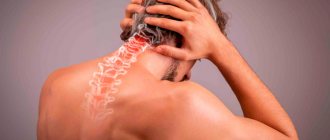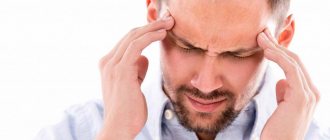Useful articles
Such a symptom as parietal headache is familiar to many. Its appearance may be due to various reasons. The described problem can occur at any age – even in children. But most often it affects women aged 30-40 years in the premenstrual and menopausal periods, as well as in the third trimester of pregnancy.
Causes of headaches in the crown area
Among the causes of parietal headaches are acute and chronic diseases of the hearing organ, nerves, muscles and joints, as well as the vascular system. Vital organs are concentrated in the area behind the ears, so ignoring painful sensations is dangerous. You should pay attention to the time of occurrence and nature of the headache in the crown, its intensity - this information is important for the attending physician during diagnosis.
Diseases of the hearing organ
If the parietal part of the head hurts on one or both sides, a hearing test must be performed. It has a complex structure, and disorders or inflammatory processes in any area can lead to painful sensations behind the ears. The difficulty of the examination lies in the fact that the internal parts of the hearing organ are not visible to the naked eye even when using standard diagnostic techniques. However, new diagnostic methods make it possible to accurately determine the cause of pain in the parietal part of the head associated with diseases of the hearing organ.
Otitis
Otitis is an inflammation of the ear in any of its parts. The cause of the disease can be injury, bacterial infection, or mechanical blockage of the ear canal. In children, chronic otitis media is often caused by hypertrophy (abnormal growth) of the adenoids. Inflammation can be acute or chronic, aseptic or purulent. It is important to treat the disease in a timely manner, since otitis often becomes chronic and worsens with hypothermia or colds, and also causes hearing impairment.
There are several types of otitis, depending on the location of the inflammatory process:
- Otitis externa - affects the ear canal and the outer surface of the eardrum, rarely spreading to the auricle. This is the most common and safest type and can be easily treated with ear drops. The pain becomes more severe when opening the mouth.
- Otitis media is an inflammation of the auditory tube and other components of the middle ear. The disease is accompanied by acute pain, which often intensifies at night. Patients also complain of a sharp deterioration in hearing, pain in the temples and frontal part of the head, noise and ringing in the ears.
- Internal otitis (labyrinthitis) is a rare, but most dangerous type. If the process spreads to the inner ear, it can lead to inflammation of the auditory nerve and hearing loss. Treatment is complex and includes a course of antibiotics, anti-inflammatory and painkillers.
With inflammation of the outer ear, the pain is one-sided, throbbing, spreads to the parietal region and intensifies during head movements. If the cause is a bacterial infection, discharge from the ear canal appears. When the internal parts are damaged, the pain spreads to the entire surface of the head. Treatment of otitis involves the use of anti-inflammatory ear drops and tablets, and also includes a course of antibiotic therapy.
Mastoiditis
Mastoiditis is inflammation of the mastoid process of the temporal bone. The disease often manifests itself as a complication of otitis media and is of bacterial origin. It is diagnosed in both adults and children of any age. This is a dangerous disease, since a bacterial infection causes purulent melting of tissues and, without appropriate treatment, can spread to important formations, including brain structures.
Mastoiditis can be identified by the following symptoms:
- the onset of clinical signs – some time (from several days to several weeks) after the development of otitis media;
- pain in the parietal region of the head and ears;
- increase in general body temperature;
- the appearance of purulent discharge from the auditory canals;
- protrusion of the auricle, possible redness of the skin and the appearance of a painful swelling behind the ear.
The basis of treatment for mastoiditis is a course of antibiotic therapy. At the same time, a regimen is prescribed aimed at relieving inflammation and pain. In the absence of timely therapy, the process can spread to the structures of the inner ear and cause purulent melting of tissues. Typical complications are perforation of the eardrum and the formation of a postauricular purulent abscess under the periosteum. Rarely, a bacterial infection with mastoiditis spreads to the temporal lobe of the brain or to the neck area with the formation of an abscess.
Blockage of the ear canals
The main cause of mechanical blockage of the auditory canals, which leads to pain in the parietal part of the head, is cerumen plug. It is formed either due to lack of hygiene and ear care, or due to increased formation of wax. In addition, the process can be triggered by the incorrect structure of the ear canals, their narrowing due to anatomical features.
In some patients, the wax plug is visible to the naked eye. It is a collection of gray or brown dense mass that completely blocks the ear canal. However, it may be located in the far part of the outer ear. Its presence can be assumed by characteristic symptoms:
- gradual deterioration of hearing, including one-sided;
- the appearance of sensations of noise, ear congestion;
- nausea and vomiting that occurs regardless of food;
- headaches in the parietal part of the head.
Blockage of the ear canal can be caused by foreign objects. More often they get into the ears of children, causing pain and hearing impairment over time. If a child complains of headaches in the parietal part of the head, it is necessary to contact an otolaryngologist to check the contents of the ears. Foreign objects are removed with special tools. It is not recommended to carry out the procedure at home, so as not to damage the eardrum.
Meniere's disease
Meniere's disease is a chronic disease of the inner ear in which the amount of endolymph in the labyrinth increases. This value is not constant, it may increase due to deterioration in the removal of fluid from the body, poor diet, or taking certain groups of drugs. The disease often manifests itself in acute form in patients aged 20 to 50 years and may have a hereditary origin. Also, increased pressure in the inner ear can be caused by head injuries or allergic diseases.
Meniere's disease can be recognized by the following signs:
- attacks of dizziness that last from 1 to 6 hours, rarely longer;
- nausea and vomiting, increased sweating;
- unsteadiness of gait, loss of coordination of movements;
- pain in the ears and in the parietal part of the head.
The labyrinth is a formation in the inner ear formed by the bones of the skull. It has a complex structure and performs several functions simultaneously. It picks up sound vibrations and transmits information to the brain, but is also a center of balance, thanks to the regulation of the amount of endolymph. Treatment of the disease is symptomatic, often the doctor prescribes diuretics and a low-salt diet. These principles allow you to stimulate the removal of excess fluid and prevent its accumulation in the body.
Fungal diseases
Otomycosis is a fungal disease that can cause pain in the crown and behind the ears. Its causative agents are various representatives of human fungal microflora. The disease can develop when an infection enters from the outside or when it spreads from other existing foci. It can also penetrate during trauma and surgery. Otomycoses often occur in humid and dusty climates. This air contains a large number of microorganisms, and after they enter the ear, an optimal environment is created for their development.
Otomycoses are classified according to the place of their occurrence and typical clinical signs:
- otomycosis of the outer ear is the most common type, manifested by itching and soreness of the auricle;
- mycotic otitis media is a dangerous disorder that is a fungal complication of bacterial otitis;
- fungal myringitis - damage to the eardrum, which can lead to thinning and perforation;
- otomycosis of the postoperative cavity - antibiotics and steroidal anti-inflammatory drugs create a suitable environment for the development of fungal microflora.
Otomycosis progresses rapidly without the use of antifungal drugs. The infection causes pain in the ears and crown of the head, itching and hearing loss. The diagnosis is made based on the examination of smears, in which various representatives of fungal microflora are found.
Cochlear neuritis
Cochlear neuritis is inflammation of the auditory nerve. This is an acute or chronic disease that leads to acute pain and hearing impairment. Acoustic neuritis can be caused by inflammation of the inner or middle ear, as well as various infectious diseases. In addition, its damage is observed in cases of poisoning, as a result of traumatic brain injuries and operations during which nerve fibers are damaged.
With cochlear neuritis, there is acute pain in the ears and head, which can be concentrated in the parietal region. Nausea, vomiting, and loss of coordination of movements also develop. Patients complain of a sharp deterioration or complete loss of hearing, tinnitus and other auditory hallucinations.
Inflammatory diseases
Pain in the parietal part of the head is the body’s response to various inflammatory reactions. Vital formations are located in this area, so it is important to undergo an examination and determine the causes of discomfort. There are several inflammatory diseases that can be diagnosed in adults and children with pain in the parietal part of the head.
- Inflammation of the temporomandibular joints is a common cause of pain in the crown area. These joints are located symmetrically near the ears and connect the upper and lower jaws. Their inflammation can be a consequence of injury or dental disease.
- Sinusitis is inflammation of the paranasal sinuses. These are cavities formed by the bones of the skull, normally filled with air. This group includes sinusitis, frontal sinusitis, ethmoiditis, sphenoiditis, as well as combined forms. When inflammation occurs, the cavities become filled with contents, which in advanced cases must be removed surgically.
- Lymphadenitis is inflammation of the lymph nodes. The process is often associated with previous infectious diseases, since the lymph nodes are an organ of immune defense. Lymphadenitis can also develop with congenital or acquired immunodeficiencies.
- Meningitis is a dangerous disease in which inflammation of the membranes of the brain occurs. The pain is acute, girdling, spreading to the parietal region and the entire surface of the head.
Inflammatory diseases should be treated in the early stages. Otherwise, they can progress and spread to surrounding organs and tissues. For therapy, a course of anti-inflammatory drugs is selected that will eliminate the main cause of pain in the parietal part of the head.
Infectious diseases
A viral or bacterial infection that enters the body from the outside is one of the main causes of pain and inflammation. Its representatives cause inflammation and pain, as well as various additional symptoms. There are several diseases that can cause pain in the parietal part of the head.
- Infectious mumps (mumps) is an inflammation of the parotid salivary glands caused by viruses. The disease most often occurs in children. The typical clinical picture includes symmetrical enlargement of the salivary glands under the ears, increased temperature and a general deterioration in health. Specific prevention includes vaccination.
- Shingles is a viral disease that causes severe headaches. In chronic cases, hearing loss may occur.
- Flu, sore throat, ARVI - viral diseases of the respiratory tract can also cause pain in the parietal region. After some time, fever, rhinitis, cough and other characteristic signs of a cold are added to the symptoms.
Infectious diseases often worsen and cause headaches in the crown of the head during the cold season and in the off-season. This is due to a decrease in vitamin intake, insufficient sunlight exposure to the skin (the main source of vitamin D), as well as a weakened immune system. Treatment is specific, prescribed based on the symptoms of the disease and an accurate diagnosis; a course of antibiotics may be required.
Other reasons
Soreness in the crown area is a typical symptom for various diseases. They have different origins and may be accompanied by additional symptoms. It is important to conduct a complete differential diagnosis in order to exclude the possibility of developing even rare pathologies and determine the exact cause of pain. The examination may reveal the following abnormalities:
- osteochondrosis – a disease of the intervertebral discs and vertebrae, which is accompanied by compression of blood vessels and nerves, acute headaches;
- migraine – attacks of unilateral headaches that have a chronic recurrent course;
- high blood pressure;
- dental diseases, including caries, incorrect position of wisdom teeth - the cause of pain that spreads from the upper jaw to the area behind the ears.
Treatment and prevention methods differ for different disorders. The attending physician will be able to select the appropriate tactics. The Clinical Brain Institute specializes in the diagnosis and treatment of disorders that are accompanied by pain in the parietal part of the head.
If the skin on the crown of your head hurts
Sometimes a condition arises in which painful sensations are concentrated on the skin of the crown and appear at the moment of touching the hair. This feeling occurs in the following situations:
- allergies to hair care products;
- tight hairstyle or too heavy hair;
- fungal disease of the scalp;
- psoriasis of the scalp;
- spasm of blood vessels surrounding and feeding the hair follicles.
These are the main reasons why the scalp on the top of your head hurts, and you can take the following steps to relieve or stop the pain:
- Stop using products that cause allergies, apply a soothing bread mask to the scalp or rinse with chamomile infusion.
- Change your hairstyle - instead of a high tight bun or ponytail, try fashionable French braids, and be sure to let your hair down at night.
- Consult a trichologist for fungal treatment.
- Take maximum care from factors that provoke the occurrence of psoriasis - reduce psycho-emotional stress, stick to a diet.
- Do not overheat or overcool the scalp.
A headache in the top of the head can occur from overexertion, or can be a harbinger of serious illnesses. Prolonged or recurring pain is a serious reason to seek advice from a specialist.
Constant headaches are a common occurrence in modern city life. At the same time, occupation, age, gender and other factors do not affect the manifestation of headaches. Impaired memory, vision, speech, dizziness and nausea may also be symptoms of a problem. If you have a headache for 5 or 40 days, you should undergo a serious examination, as such a symptom may indicate serious health problems. Serious examinations include CG, ultrasound, ECG, Echo, blood test, CT, MRI and many others.
Diagnostic methods
To diagnose pain in the parietal region, instrumental and laboratory techniques are used that make it possible to determine the exact cause of the discomfort. A simple examination reveals inflammatory processes, neoplasms, abscesses, as well as symptoms of infectious diseases. However, to understand the full picture of the disease, the following tests may be prescribed:
- examination of smears and scrapings from the ears, skin, and mouth;
- blood tests to determine pathogens of viral diseases and pathologies of individual organs;
- consultation with an otolaryngologist - instrumental techniques will allow you to identify various diseases of the hearing organ;
- examination by a dentist - prescribed if caries, abscesses, or incorrect position of teeth during their growth are suspected;
- CT, MRI of the head - these techniques are used to diagnose brain tumors.
The Clinical Brain Institute has modern equipment that allows for accurate and high-quality analyzes. There is also the opportunity to consult with general and specialist doctors who specialize in various areas.
Why does pain occur?
It must be said that the main reasons for the development of vertex cephalgia may lie in excessive physical (muscular) tension or chronic fatigue of the body.
In addition, quite often this part of the skull can become intensely painful due to powerful stressful situations experienced by the patient.
Unfortunately, no one can be immune from cephalgia of the vertex region, neither office workers who spend their working day behind a computer monitor, nor athletes who undergo significant physical activity, nor the elderly, nor children.
And all because every modern person, as a rule, leads a fairly active lifestyle and is periodically exposed to stress, fatigue or lack of sleep.
Tension cephalalgia with localization in the vertex region is characterized by a somewhat pressing or compressive nature, beginning in the occipital region and subsequently moving literally throughout the entire head.
The main reasons for the development of such cephalgia can be concluded:
- In chronic fatigue of the body;
- Not quite healthy (often unhealthy) nutrition;
- Muscle strain;
- The presence of harmful or even dangerous habits to health - smoking, alcohol abuse.
However, vertex cephalgia is not always caused by such harmless causative factors; unfortunately, sometimes the causes of such ailments can be much more serious. Why else might a headache of this localization occur?
As it turns out, vertex cephalgia can often occur as a result of long-term untreated (progressive) hypertension.
However, in this case, the nature of the pain will be somewhat different. Ailments associated with increased blood pressure are usually pulsating and quite protracted.
And these are not all the answers to the question: why does cephalgia of the crown of the head develop. The cause of the described problem may well be compression of the spinal roots (nerves) located in the cervical spine.
In addition, the described symptoms of cephalalgia may well also have diseases such as:
- Cerebrovascular accidents, including stroke;
- Frontal sinusitis, otitis media, sinusitis, acute respiratory diseases;
- Neuritis of the occipital or facial nerve;
- Some endocrine diseases.
- Eye diseases;
- Brain tumors.
You must understand that it is sometimes not possible to independently understand the causes of cephalalgia, since the patient is often unable to objectively assess the degree of intensity of pain.
For example, sometimes an incredibly emotional patient experiencing migraine or tension cephalalgia may claim that her head is literally exploding. At the same time, some patients may suffer a stroke on their legs, claiming that their head hurt just a little.
Patient Vladimir, 40 years old. The man was taken to the hospital at the insistence of his wife, a nurse by training. According to the patient, “the top of his head ached quite a bit, he could take analgin and go to work.”
However, his wife noticed the unsteadiness of his gait and the distortion of his smile on the left side and called an ambulance. After a detailed examination, the patient was diagnosed with a transient cerebrovascular accident and a high risk of stroke. The patient was prescribed full hospital treatment.
Patient Larisa, 56 years old. The woman complained of excessively intense headaches in the vertex area. The patient assured that cephalalgia was almost impossible to tolerate due to its excessive intensity.
After consulting a psychoneurologist, it turned out that the woman suffers from migraine-like conditions and periodically undergoes treatment in the department of borderline conditions of the psychoneurological dispensary. The patient was prescribed adequate treatment with sedatives.
Treatment of parietal headaches
Treatment tactics are selected individually, depending on the exact diagnosis. Most diseases can be treated conservatively, using tablets, injections, ointments and drops. The scheme may include the following steps:
- anti-inflammatory therapy - tablets and injections help relieve inflammation and pain;
- antibiotics - prescribed for bacterial infections, as well as to prevent its occurrence in inflammatory diseases;
- additional methods - the doctor may prescribe means for removing excess fluid, antifungal and other drugs;
- physiotherapy – a set of techniques to improve hearing in case of ear diseases;
- surgical methods are necessary for removing foreign bodies from the ear canals, treating purulent sinusitis, as well as for removing abscesses and neoplasms.
At the Clinical Brain Institute there are opportunities to undergo inpatient or outpatient treatment. The regimen will include only those drugs and procedures that will help quickly get rid of the cause of pain and symptoms of the underlying disease. At home, it is important to follow all the recommendations of doctors in order not only to relieve pain, but also to prevent further development of the disease.
What are the symptoms of pain?
To establish the correct diagnosis and treatment, one symptom is not enough. If the upper part of the head hurts especially badly, there are many reasons.
Therefore, the most important responsibility of the patient is to provide the doctor with detailed accompanying symptoms. First of all, you need to determine in which area the head spasm is localized and how it reacts to pressure.
It should be noted that this is not always easy to do, especially if painful spasms do not go away for a long time.
Methods for preventing parietal headaches
To prevent diseases of the hearing organ, it is necessary to maintain ear hygiene and immediately consult a doctor if foreign objects get into the ear canals. It is also important to strengthen your immune system, get enough vitamins and lead an active lifestyle at any time of the year. To prevent swelling and high blood pressure, you need to monitor your diet and avoid large amounts of salt and spices.
Doctors at the Clinical Brain Institute emphasize that timely prevention will help prevent most viral diseases, dental problems and hearing impairment.
Clinical Brain Institute Rating: 3/5 — 10 votes
Share article on social networks
Muscle fatigue
This is the most common type of illness, which is manifested by relentless and constant pain. The entire perimeter of the head hurts, most often in the back and neck, less often in the temples or the center of the forehead.
Sometimes the eye area also hurts. Often the attack is accompanied by nausea and vomiting.
The most common cause is stress, during which the muscles in the head and neck contract.
Combine ginger tea with mint or a few drops of peppermint essential oil. This should effectively relieve pain.
Peppermint oil can also be applied to the temples to achieve a cooling effect and relax the muscles of the head and neck. In addition, ginger tea suppresses inflammation.
Migraines most often affect people between 25 and 55 years of age, but can occur at any age. The disease is thought to affect 1 in 9 people, usually women.
This is a more complex type of pain than previous types and includes a much larger number of symptoms.
With a migraine, the headache is intense, the pain is severe and throbbing, and is localized on one side of the head. In a third of cases - on both sides.
The pain is often combined with other symptoms, such as:
- Nausea.
- Vomit.
- Blurred vision.
- Dizziness.
- Sensitivity to light, sound and smell.
- Numbness or tingling of the face.
- The pain usually shoots down from the top of the head.
Vitamin B2 (riboflavin), magnesium and omega-3 fatty acids have been shown to help many migraine patients relieve their attacks.
Thus, these elements must be present in the diet in sufficient quantities; you can consume them in the form of dietary supplements.
Pain in the upper part of the head is observed in people who regularly experience stressful situations or remain in an uncomfortable position for a long time. In such situations, you should not immediately resort to the help of medications: you can take a walk in the fresh air, do a light neck massage, lie down in a relaxed position, or take a hot shower.
I beg you, do not remove papillomas! To make them disappear, add 3 drops to a glass of water.
A harbinger of serious illness
Cluster cephalgia, in which the patient constantly experiences pinpoint throbbing pain in the right side of the head, may indicate the development of the following diseases and conditions:
- brain tumors of various origins;
- withdrawal state;
- aneurysms;
- hematomas due to traumatic brain injuries and concussions;
- poisoning with certain drugs;
- taking vasodilators (for example, nitroglycerin) or histamine.
Which doctor treats migraines?
In order to permanently get rid of attacks of cluster cephalgia or point migraine, to find out why the back of the head hurts, you should undergo a full examination. By influencing the source of the problem, long-term remission can be achieved. You can make an appointment with a paid neurologist. But then all the research will be paid. As a result, the total amount that the patient will have to spend to find out the cause of the pain will be at least twenty thousand rubles (you will need to pay for an MRI of the brain, an electroencephalogram, and a decoding of the result).
You can go a different route and not spend a penny on diagnostics. But this will take more time. The patient must take his medical insurance card and go to the district clinic, where he will be given a coupon for an appointment with a local physician. He, in turn, will issue a coupon for a consultation with a neurologist. Already there, after all the complaints have been stated, further treatment will be prescribed and a referral for the necessary research will be issued.
Advice from neurologists: how to avoid the development of cluster and point pain
A list of simple recommendations that will help prevent the development of migraines of any etiology and diseases that provoke them:
- You need to sleep at least eight hours every night. no matter what problems the patient may be experiencing, no matter what stress he may be experiencing, a good night’s sleep should be a must.
- Good nutrition is the basis of a healthy nervous system. Under no circumstances should you adhere to strict diets and starve yourself - even if the consequences do not appear immediately, they will come over time (the nervous system exhausted by fasting does not forgive such an attitude).
- A sufficient amount of amino acids, vitamins and microelements in the diet.
- The correct reaction to stress is to remain calm in any situation, so that later you don’t think about why your head hurts (the back of your head, the crown or your forehead).
- Moderate physical education - do not exhaust yourself with exercises, do not provoke overwork.









